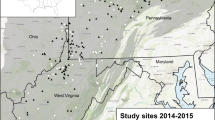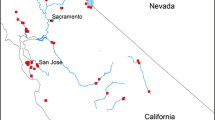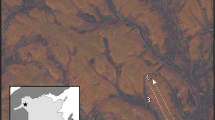Abstract
Context
Resource movements across ecosystem boundaries are important determinants of the diversity and abundance of organisms in the donor and recipient ecosystem. However the effects of cross-ecosystem movements of materials at broader spatial extents than a typical field study are not well understood.
Objectives
We tested the hypotheses that (1) variation in abundance of 57 forest songbird species within four foraging guilds is explained by modeled emergent aquatic insect biomass inputs from adjacent lakes and streams and (2) the degree of association varies across foraging guilds and species within guilds. We also sought to determine the importance of emergent aquatic insects while accounting for variation in local forest cover and edge.
Methods
We spatially modeled the degree to which distribution and abundance of songbirds in different foraging guilds was explained by modeled emergent aquatic insect biomass. We used multilevel models to simultaneously estimate the responses of species in four different insectivorous guilds. Bird abundance was summarized from point counts conducted over 24 years at 317 points.
Results
Aerial insectivores were more abundant in areas with high estimated emergent insect biomass inputs to land (regression coefficient 0.30, P < 0.05) but the overall abundance of gleaners, bark-probers, and ground-foragers was not explained by estimated emergent insect abundance. The coursing aerial insectivores had the strongest association with emergent insects followed by willow flycatcher, olive-sided flycatcher, and alder flycatcher.
Conclusions
Modeling cross-ecosystem movements of materials at broad spatial extents can effectively characterize the importance of this ecological process for aerial insectivorous songbirds.




Similar content being viewed by others
Data availability
All data generated or analyzed during this study are included in this published article [and its supplementary information files].
References
Bartrons M, Papes M, Diebel MW, Gratton C, Vander Zanden MJ (2013) Regional level inputs of emergent aquatic insects from water to land. Ecosystems 16:1353–1363
Bates D, Maechler M., Bolker B, Walker S (2014) lme4: linear mixed-effects models using Eigen and S4. R package version 1.1–7, https://CRAN.R-project.org/package=lme4
Beal FE (1912) Food of our important flycatchers. Biological Survey Bulletin 44:1–67
Bub BR, Flaspohler DJ, Huckins CJF (2004) Riparian and upland breeding-bird assemblages along headwater streams in Michigan’s upper peninsula. J Wildl Manag 68:383–392
Bultman H, Hoekman D, Dreyer J, Gratton C (2014) Terrestrial deposition of aquatic insects increases plant quality for insect herbivores and herbivore density. Ecol Entomol 39:419–426
Burke DM, Nol E (1998) Influence of food abundance, nest-site habitat, and forest fragmentation on breeding Ovenbirds. Auk 115:96–104
Cummins KW, Wuycheck JC (1971) Caloric equivalents for investigations of ecological energetics. Int Assoc Theoret Appl Limnol Spec Commun 18:1–158
Diggle PJ, Ribeiro PJ Jr (2007) Model based geostatistics. Springer, New York
Dreyer J, Hoekman D, Gratton C (2012) Lake-derived midges increase abundance of shoreline terrestrial arthropods. Oikos 121:252–258
Ehrlich P, Dobkin DS, Wheye D (1988) Birder’s handbook. Simon and Schuster, New York
Epanchin PN, Knapp RA, Lawler SP (2010) Nonnative trout impact an alpine-nesting bird by altering aquatic-insect subsidies. Ecology 91:2406–2415
ESRI (2011) ArcGIS desktop: release 10. Environmental Systems Research Institute, Redlands
Fitzpatrick JW (1980) Foraging behavior of neotropical tyrant flycatchers. Condor 82(1):43–57
Gelman A, Hill J (2006) Data analysis using regression and multilevel/hierarchical models. Cambridge University Press, Cambridge
Gende SM, Willson MF (2001) Passerine densities in riparian forests of southeast Alaska: potential effects of anadromous spawning salmon. Condor 103:624–629
Gorzo JM, Pidgeon AM, Thogmartin WE, Allstadt AJ, Radeloff VC, Heglund PJ, Vavrus SJ (2016) Using the North American Breeding Bird Survey to assess broad-scale response of the continent's most imperiled avian community, grassland birds, to weather variability. Condor 118:502–512
Gratton C, Donaldson J, Vander Zanden MJ (2008) Ecosystem linkages between lakes and the surrounding terrestrial landscape in northeast Iceland. Ecosystems 11:764–774
Gratton C, Vander Zanden MJ (2009) Flux of aquatic insect productivity to land: comparison of lentic and lotic ecosystems. Ecology 90:2689–2699
Gray LJ (1993) Response of insectivorous birds to emerging aquatic insects in riparian habitats of a tallgrass prairie stream. Am Midl Nat 129:288–300
Harrison XA (2014) Using observation-level random effects to model overdispersion in count data in ecology and evolution. PeerJ 2:e616
Henschel JR, Mahsberg D, Stumpf H (2001) Allochthonous aquatic insects increase predation and decrease herbivory in river shore food webs. Oikos 93:429–438
Hoekman D, Bartrons M, Gratton C (2012) Ecosystem linkages revealed by experimental lake-derived isotope signal in heathland food webs. Oceologia 170:735–743
Holmes RT, Black CP, Sherry TW (1979) Comparative population bioenergetics of three insectivorous passerines in a deciduous forest. Condor 81:9–20
Holmes RT, Schultz JC (1988) Food availability for forest birds: effects of prey distribution and abundance on bird foraging. Can J Zool 66:720–728
Homer C, Dewitz J, Fry J, Coan M, Hossain N, Larson C, Herold N, McKerrow A, VanDriel JN, Wickham J (2007) Completion of the 2001 national land cover database for conterminous United States. Photogramm Eng Remote Sens 73:337–341
Howe RW, Roberts LJ (2006) Sixteen years of habitat-based bird monitoring in the Nicolet National Forest. In: Ralph CJ, Rich TD (eds) Bird conservation implementation and integration in the Americas, General Technical Report PSW-GTR-191. US Department of Agriculture, Forest Service, Albany, pp 963–973
Howe RW, Wolf AT, Rinaldi T (1995) Monitoring birds in a regional landscape: lessons from the Nicolet National Forest Bird Survey. USDA Forest Service Gen. Tech. Rep. PSW-GTR-149
Ives AR, Einarsson Á, Jansen VA, Gardarsson A (2008) High-amplitude fluctuations and alternative dynamical states of midges in Lake Myvatn. Nature 452:84–87
Iwata T, Nakano S, Murakami M (2003) Stream meanders increase insectivorous bird abundance in riparian deciduous forests. Ecography 26:325–337
Jackson MM, Turner MG, Pearson SM, Ives AR (2012) Seeing the forest and the trees: multilevel models reveal both species and community patterns. Ecosphere 3:1–16
Kennedy CH (1950) The relation of American dragonfly-eating birds to their prey. Ecol Monogr 20:103–142
Knight TM, McCoy MW, Chase JM, McCoy KA, Holt RD (2005) Trophic cascades across ecosystems. Nature 437:880–883
Kristan WB III, Johnson MD, Rotenberry JT (2007) Choices and consequences of habitat selection for birds. Condor 109:485–488
Lindsay AR, Gillum SS, Meyer MW (2002) Influence of lakeshore development on breeding bird communities in a mixed northern forest. Biol Conserv 107:1–11
MacArthur RH (1958) Population ecology of some warblers of northeastern coniferous forests. Ecology 39:599–619
Marczak LB, Thompson RM, Richardson JS (2007) Meta-analysis: trophic level, habitat, and productivity shape the food web effects of resource subsidies. Ecology 88(1):140–148
McCollin D (1998) Forest edges and habitat selection in birds: a functional approach. Ecography 21(3):247–260
McGarigal K, Cushman SA, Ene E (2012) FRAGSTATS v4: spatial pattern analysis program for categorical and continuous maps. Computer software program produced by the authors at the University of Massachusetts, Amherst. https://www.umass.edu/landeco/research/fragstats/fragstats.html
Morse DH (1989) American warblers: an ecological and behavioral perspective. Harvard University Press, Cambridge
Nakano S, Murakami M (2001) Reciprocal subsidies: dynamic interdependence between terrestrial and aquatic food webs. Proc Natl Acad Sci USA 98:166–170
Nebel S, Mills A, McCraken J, Taylor PD (2010) Declines of aerial insectivores in North America follow a geographic gradient. Avian Conserv Ecol 5:1
Niemi GJ, Howe RW, Sturtevant BR, Parker LR, Grinde AR, Danz NP, Nelson MD, Zlonis EJ, Walton NG, Giese EEG and Lietz SM (2016) Analysis of long-term forest bird monitoring data from national forests of the western Great Lakes Region. Gen. Tech. Rep. NRS-159. Newtown Square, PA: US Department of Agriculture, Forest Service, Northern Research Station, pp 1–322
Pickett ST, Cadenasso ML (1995) Landscape ecology: spatial heterogeneity in ecological systems. Science 269(5222):331–334
Polis GA, Anderson WB, Holt RD (1997) Toward an integration of landscape and food web ecology: the dynamics of spatially subsidized food webs. Annu Rev Ecol Syst 28:289–316
Polis GA, Hurd SD (1995) Extraordinarily high spider densities on islands: flow of energy from the marine to terrestrial food webs and the absence of predation. Proc Natl Acad Sci USA 92:4382–4386
R Core Team (2013) R: A language and environment for statistical computing. R Foundation for Statistical Computing, Vienna
Ribeiro PJ Jr, Diggle PJ (2001) geoR: a package for geostatistical analysis. R-NEWS 1(2):15–18
Robinson SK, Holmes RT (1982) Foraging behavior of forest birds: the relationships among search tactics, diet, and habitat structure. Ecology 63:1918–1931
Sabo JL, Power ME (2002) River–watershed exchange: effects of riverine subsidies on riparian lizards and their terrestrial prey. Ecology 83:1860–1869
Sherry TW (1979) Competitive interactions and adaptive strategies of American Redstarts and Least Flycatchers in a northern hardwoods forest. Auk 96:265–283
Smith TM, Shugart HH (1987) Territory size variation in the ovenbird: the role of habitat structure. Ecology 68:695–704
Van Wilgenburg SL, Mazerolle DF, Hobson KA (2001) Patterns of arthropod abundance, vegetation, and microclimate at boreal forest edge and interior in two landscapes: implications for forest birds. Ecoscience 8(4):454–461
Vander Zanden MJ, Gratton C (2011) Blowin' in the wind: reciprocal airborne carbon fluxes between lakes and land. Can J Fish Aquat Sci 68:170–182
Veech JA, Pardieck KL, Ziolkowski DJ Jr (2017) How well do route survey areas represent landscapes at larger spatial extents? An analysis of land cover composition along Breeding Bird Survey routes. Condor 119(3):607–615
WDNR (2011) Online document. https://dnr.wi.gov/maps/gis/datahydro.html. Madison, WI.
Whitaker DM, Carroll AL, Montevecchi WA (2000) Elevated numbers of flying insects and insectivorous birds in riparian buffer strips. Can J Zool 78:740–747
Whitaker DM, Montevecchi WA (1997) Breeding bird assemblages associated with riparian, interior forest, and nonriparian edge habitats in a balsam fir ecosystem. Can J For Res 27(8):1159–1167
Wolf AT, Howe RW, Davis GJ (1995) Detectability of forest birds from stationary points in northern Wisconsin. In: Ralph CJ, Sauer JR, Droege S (eds) Monitoring bird populations by point counts. Gen. Tech. Rep. PSW-GTR-149, vol 149. US Department of Agriculture, Forest Service, Pacific Southwest Research Station, Albany, pp 19–24
Acknowledgements
PS was supported by a NSF Graduate Research Fellowship. MB, JVZ, and CG were supported by National Science Foundation Grants DEB-0717148, DEB-LTREB-1052160, and DEB-LTREB-1556208. We thank A.R. Ives who provided valuable suggestions that improved the analysis, the many Nicolet National Forest Bird Survey volunteers who gathered the bird count data over 24 years, and the Department of Forest and Wildlife Ecology, UW-Madison, for support.
Author information
Authors and Affiliations
Contributions
PS analyzed the data and wrote the paper. MB, JVZ, and CG conceived the idea and assisted with writing the paper. JG assisted with data analysis and interpretation of results and assisted with writing the paper. RH contributed the bird data and assisted with writing the paper. AP assisted with the idea, analysis, and writing.
Corresponding author
Additional information
Publisher's Note
Springer Nature remains neutral with regard to jurisdictional claims in published maps and institutional affiliations.
Electronic supplementary material
Below is the link to the electronic supplementary material.
Rights and permissions
About this article
Cite this article
Schilke, P.R., Bartrons, M., Gorzo, J.M. et al. Modeling a cross-ecosystem subsidy: forest songbird response to emergent aquatic insects. Landscape Ecol 35, 1587–1604 (2020). https://doi.org/10.1007/s10980-020-01038-0
Received:
Accepted:
Published:
Issue Date:
DOI: https://doi.org/10.1007/s10980-020-01038-0




